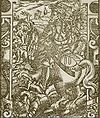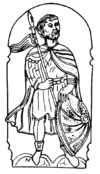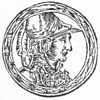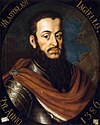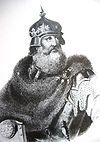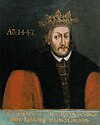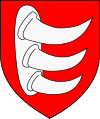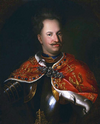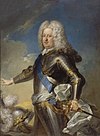|
List of heads of state of Lithuania
The article is a list of heads of state of Lithuania over historical Lithuanian state. The timeline includes all heads of state of Lithuania as a sovereign entity, legitimately part of a greater sovereign entity, a client state, or a constituent republic subject to an outside authority. Currently, the head of state is the President of Lithuania.  During the inaugurations of Lithuanian monarchs until 1569, the Gediminas' Cap was placed on the monarch's heads by the Bishop of Vilnius in Vilnius Cathedral.[1] Kingdom of Lithuania (1251–1263)Title: King of Lithuania (Lithuanian: Lietuvos karalius). Dates are approximate because of scant written sources. House of Mindaugas (1253–1263)
Grand Duchy of Lithuania (1263–1569)Title: Grand Duke (Lithuanian: didysis kunigaikštis; Belarusian: vialiki kniaź; Polish: wielki książę). Dates are approximate because of scant written sources. House of Mindaugas (1263–1267)
House of Monomakh (1267–1269)
House of Mindaugas (1269–1285)
House of Gediminas (1285–1440)
House of Jagiellon (1440–1569)The act of personal union with Poland was signed as early as 1385; however, the continuous line of common rulers of the two countries started only with Casimir IV (even then, Polish and Lithuanians twice selected different rulers following the death of an earlier common monarch, but the Lithuanian one always eventually assumed the Polish throne). The monarchs retained separate titles for both parts of the state, and their numbering was kept separate. The Jagiellon dynasty was a direct continuation of the Gediminids.
Polish–Lithuanian Commonwealth (1569–1795)The Polish–Lithuanian Commonwealth was established by the Union of Lublin in 1569. The elected King of Poland was automatically a Grand Duke of Lithuania (until then the Lithuanian dukedom was hereditary). The first common ruler of both countries was Sigismund II Augustus. During the Deluge of the Second Northern War, Lithuania signed the Union of Kėdainiai with the Swedish Empire in 1655, thus de jure ending its union with Poland. However, due to Sweden's losses, the agreement soon fell out of favor and was not properly enforced, leading to the further continuation of the Polish–Lithuanian Commonwealth. Following the partitions in 1772, 1793, and 1795, the commonwealth ceased to exist and Lithuania proper became part of the Russian Empire for 123 years. There are some gaps in the timeline as it took a while to elect a new king. The first Grand Duke elected after the Gediminid line became extinct and after the Valois fled back to France was Stephen Báthory, who had made an effort to be recognized as Grand Duke of Lithuania by establishing Vilnius University. Title: King of Poland and Grand Duke of Lithuania Lithuanian: Lenkijos karalius ir Lietuvos didysis kunigaikštis Polish: Król Polski, wielki książę litewski Latin: Rex Poloniae et Magnus Dux Lituaniae
Kingdom of Lithuania (1918)The Council of Lithuania declared independence on 16 February 1918 and invited Wilhelm of Urach to become king of Lithuania. The name of the state was the Kingdom of Lithuania. On 9 July 1918, Duke Wilhelm accepted the offer and took the name Mindaugas II. However, on 2 November the council revoked this decision as it was likely Germany would lose the war. House of Urach (1918)
Republic of Lithuania (1918–1940)Presidents of the Presidium of the Council of LithuaniaThe state of Lithuania was ruled by the Presidium of the State Council of Lithuania, its chairman was de facto Head of State. The institution of President was established on 4 April 1919. Chairman of the Presidium Antanas Smetona was elected as First President of the State of Lithuania by the State Council of Lithuania and was the only one in under whose rule this position has been considered the office of the head of state.
Presidents of the Republic of LithuaniaThe institution of President (Lithuanian: Prezidentas) was created on 4 April 1919. Antanas Smetona was elected as the first President of Lithuania.
Posthumously recognized acting Presidents
Heads of the Lithuanian Diplomatic ServiceFollowing Lithuania's occupation by the Soviet Union on 15 June 1940, in his telegram dated 31 May 1940, the last Foreign Minister Juozas Urbšys provisioned that, in the event of occupation, Stasys Lozoraitis, minister extraordinary and plenipotentiary to Rome, be appointed the head of the Lithuanian diplomatic service. The Lithuanian diplomatic service became a Government in exile that was a critical piece to ensuring the recognition of the continuity of Lithuanian legal statehood until independence after the Dissolution of the Soviet Union.[4]
Lithuanian Soviet Socialist Republic (1940–1941)The Soviet Union occupied Lithuania and established the Lithuanian SSR in July 1940. First Secretaries of the Central Committee of the Communist Party of LithuaniaLithuanian: Lietuvos komunistų partijos Centro komiteto pirmasis sekretorius; Russian: Первый секретарь Центрального Комитета Коммунистической партии Литвы.
Generalbezirk Litauen (1941–1944)As Nazi Germany attacked the Soviet Union in Operation Barbarossa, Lithuania liberated itself with the anti-Soviet June Uprising and re-declared Lithuanian Independence. Lithuania was ruled for some time by the Provisional Government of Lithuania, whose prime minister was Juozas Ambrazevičius. The Provisional Government was formed on 23 June 1941, but was dissolved on 5 August of the same year. Lithuania was occupied by the Germans, who formed Generalbezirk Litauen on 25 July 1941, which was governed by the administration of general commissioner Adrian von Renteln and was a part of Reichskommissariat Ostland. General Commissioners of Generalbezirk LitauenLithuanian: Lietuvos generalinės srities generalinis komisaras; German: Generalkommissar des Generalbezirks Litauen.
Lithuanian Soviet Socialist Republic (1944–1990)As Nazi Germany retreated, the Soviet Union reoccupied the country and reestablished the Lithuanian SSR in 1944. The Presidium of the Supreme Soviet de jure acted as a collective head of state from 25 August 1940 to 11 March 1990. However, the Supreme Soviet de facto was controlled by the Communist Party of Lithuania led by the First Secretary. First Secretaries of the Central Committee of the Communist Party of Lithuania
Republic of Lithuania (1990–present)The leader of the Supreme Council was the official head of state from the declaration of independence on 11 March 1990 until the new Constitution came into effect in 1992 establishing the office of President and the institution of Seimas. The state and its leadership were not recognized internationally until September 1991 [NB: Iceland was the first country to recognise the regained independence of Lithuania in February 1991.[5] Title from 1990 to 1992: Chairman of the Supreme Council (Parliament; Lithuanian: Aukščiausiosios Tarybos pirmininkas). Title from 1992 onwards: President (Lithuanian: prezidentas).
Timeline See alsoReferences
External links |
||||||||||||||||||||||||||||||||||||||||||||||||||||||||||||||||||||||||||||||||||||||||||||||||||||||||||||||||||||||||||||||||||||||||||||||||||||||||||||||||||||||||||||||||||||||||||||||||||||||||||||||||||||||||||||||||||||||||||||||||||||||||||||||||||||||||||||||||||||||||||||||||||||||||||||||||||||||||||||||||||||||||||||||||||||||||||||||||||||||||||||||||||||||||||||||||||||||||||||||||||||||||||||||||||||||||||||||||||||||||||||||||||||||||||||||||||||||||||||||||||||||||||||||||||||||||||||||||||||||||||||||||||||||||||||||||||||||||||||||||||||||||||||||||||||||||||||||||||||||||||||||||||||||||||||||||||||||||||||||||||||||||||||||||||||||||||||||||||||||||||||||||||||||||||||||||||||


